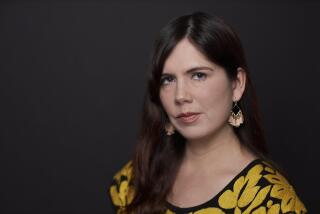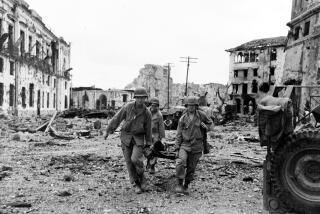The Hard Work of Forgiveness
- Share via
Traveling through the rugged mountains of East Timor in March, my car got stuck in the middle of a river. The back wheels spun around uselessly, then the engine died, but my driver, Afonso Martins, wasn’t worried. “Someone will come,” he announced. Ten minutes later, the car had filled up with water and we crawled out onto the hood. “Someone will come,” he repeated. A few minutes later, a dump truck showed up driven by Martins’ cousin’s best friend. As we were towed out of the water, I remarked that it was lucky to find such a connection in the middle of nowhere. Martins was amused. “If we stayed in this river, we’d meet my whole family.”
That’s how East Timor is. About the size of Connecticut, on one-half of an island in the Indonesian archipelago north of Australia, the whole country has a population of just 800,000--significantly fewer people than would be in the new San Fernando Valley city if it secedes. Village life is traditional, and people know their neighbors intimately. If you get stuck in a stream, you’ll probably know the next person who comes down the road, which is both a benefit and a challenge for the East Timorese as they attempt to move beyond the past into a new era.
Monday, in a ceremony attended by former President Clinton, East Timor will declare itself fully independent, something it has not been for more than 400 years, except for a few chaotic days in 1975 when it declared itself a country after the end of Portuguese colonial rule. With few objections from the U.S. and Australian governments, Indonesia almost immediately sent in troops and seized control, annexing it the following year. For the next 24 years, guerrillas in the Revolutionary Front for an Independent East Timor--widely known as Fretilin--battled the Indonesian army. It’s impossible to find an East Timorese person who did not lose a friend or family member during this period.
When political changes in Indonesia allowed for a 1999 referendum, more than 90% of East Timor’s people voted for independence. But in the weeks that followed, the Indonesians and a variety of militias, whose East Timorese members had acted as death squads for the Indonesians, burned down 80% of the country’s buildings and forced more than 250,000 people to cross the border to the province of West Timor.
Now that things have settled down and East Timor will finally become fully independent, there is widespread cause for rejoicing as close-knit communities rebuild. But there is also bitter resentment--particularly toward the East Timorese militia members who now are attempting to re-integrate into those communities.
During the final decade of Indonesian rule, the militia burned down countless homes and killed, tortured or raped people suspected of supporting the Fretilin guerrillas. Many of the destroyed homes still stand, their soot-covered walls and twisted metal roofs serving as a constant reminder of the past. Traveling through the countryside recently, I quickly discovered how everyone remembers who burned down another person’s home five years ago.
Domingos Soares, a muscular, bearded man of 49, led a militia in Letefoho, a small town in the mountains south of Dili. After fleeing across the border to West Timor, he has now returned to his home, where we spoke. At first, convinced that I was some kind of official investigating war crimes, he held his body tightly and stared at the ground. Yes, he was a commandante in the militia. Yes, he burned down people’s homes.
Gradually, he relaxed and began to speak more freely. “When the [Indonesian military] came to me, they said, ‘You are a friend, so make a [militia]. If you are not our friend, then you are our enemy,’” Soares said, looking embarrassed and shrugging his shoulders as if to indicate that he had no choice.
Right after his return, he said, “I was very frightened.” His neighbors all knew he had been part of a militia. “Then the priest talks about me in church and a man from Fretilin also talks about me. They say, ‘The fighting is over. Our children need peace.’”
Not everyone, though, finds it easy to forgive. Moises Dos Santos, 56, was on the other side in the long conflict, a village leader in Liquica, a coastal village south of the capital. He watched as local farmers were organized and given guns by the Indonesian army. The new militiamen were told that they would be paid 25,000 Indonesian rupiah (about $2.50) and a bag of rice for every person they killed. In 1999, Dos Santos was hiding in the fields near the local church when the militia executed his aunt. Now many of these people have returned, and Dos Santos sees them selling fruit by the side of the road.
“When I see [former militia members] it is difficult to put my anger down,” he said recently. “I want to be responsible, but....” He made a fist and thumped his chest: “My heart is still hard.”
For East Timor to move forward, the legal and personal issues of reconciliation must be addressed, which is why they have now been incorporated into official government policy.
An independent Commission for Reception, Truth and Reconciliation has been organized, and it recently started its activities. The commission will investigate human rights violations during the last 25 years and determine which individuals were responsible. Serious crimes--such as murder or torture--will be referred to the country’s new justice system. Other offenses, such as theft, arson or the killing of livestock, will require the perpetrator to perform “an act of reconciliation,” such as a period of community service or a public apology.
Aniceto Guterres, a 35-year-old lawyer and human rights activist, heads the reconciliation commission. He knows he has a difficult job. “We can have reconciliation if the East Timorese people have faith in the rule of law,” he said. “They must believe that past crimes will be handled fairly by the legal system.”
East Timor is 95% Roman Catholic, and Guterres believes that the church must have an active role in the process of reconciliation. “Religion is very important here and not in an abstract way,” he explained. “The church leaders are often the leaders of the community.”
During the months before independence, Carlos Ximenes Belo, the Timorese bishop who shared the 1996 Nobel Peace Prize, has traveled across the country telling people to avoid vigilante justice and trust the new government. But even as the new government and the church press for national reconciliation, people here realize that East Timor’s future will be determined in the villages. When the once-feared militia members return without their weapons, thousands of people will make private decisions to forgive or seek revenge.
On the day I visited the town of Zumalai, near the border, Father Augusto Sampio and his parishioners were making preparations for 51 ex-militia members to return for a brief visit. This would be the third time the group had traveled across the border for a one-day event. Father Augusto planned to preach a sermon, several of the militia members would make public apologies, and then members of the community would ask the exiles to return with their families.
“After the Mass, I will explain that the Indonesians wanted to divide us into two groups,” the priest said. “Then I tell everyone that the people who died were a sacrifice so that our nation could appear.”
Will this process lead to reconciliation? Father Augusto gazed across the packed-dirt yard in front of his church at the children walking home from school for the midday meal. “I pray,” the priest whispered. “I pray.”
More to Read
Sign up for Essential California
The most important California stories and recommendations in your inbox every morning.
You may occasionally receive promotional content from the Los Angeles Times.










